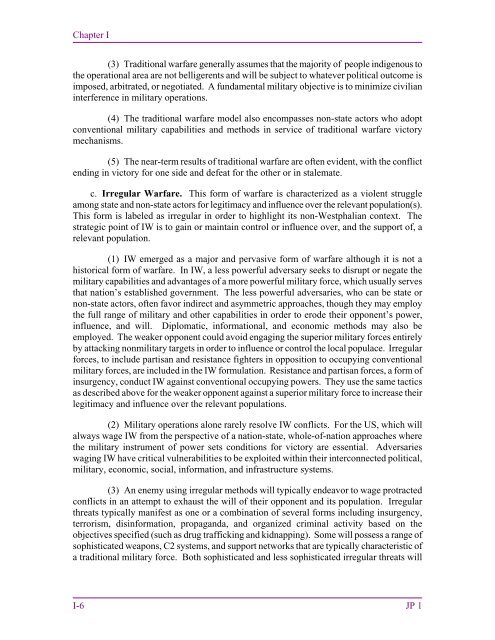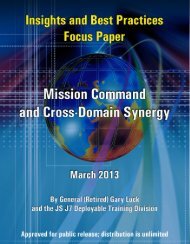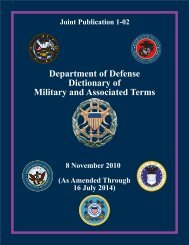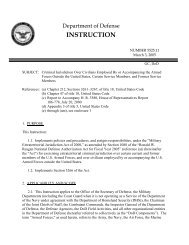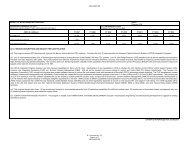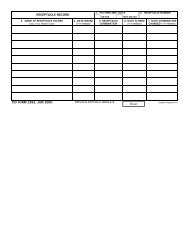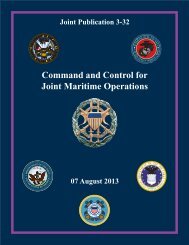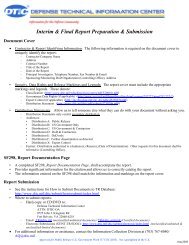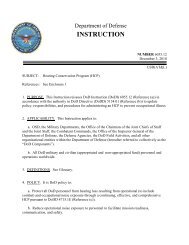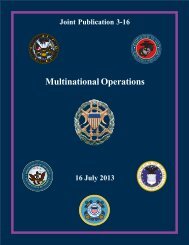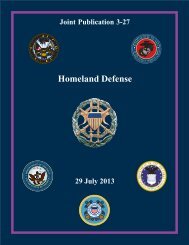JP 1, Doctrine for the Armed Forces of the United States - Defense ...
JP 1, Doctrine for the Armed Forces of the United States - Defense ...
JP 1, Doctrine for the Armed Forces of the United States - Defense ...
You also want an ePaper? Increase the reach of your titles
YUMPU automatically turns print PDFs into web optimized ePapers that Google loves.
Chapter I<br />
(3) Traditional warfare generally assumes that <strong>the</strong> majority <strong>of</strong> people indigenous to<br />
<strong>the</strong> operational area are not belligerents and will be subject to whatever political outcome is<br />
imposed, arbitrated, or negotiated. A fundamental military objective is to minimize civilian<br />
interference in military operations.<br />
(4) The traditional warfare model also encompasses non-state actors who adopt<br />
conventional military capabilities and methods in service <strong>of</strong> traditional warfare victory<br />
mechanisms.<br />
(5) The near-term results <strong>of</strong> traditional warfare are <strong>of</strong>ten evident, with <strong>the</strong> conflict<br />
ending in victory <strong>for</strong> one side and defeat <strong>for</strong> <strong>the</strong> o<strong>the</strong>r or in stalemate.<br />
c. Irregular Warfare. This <strong>for</strong>m <strong>of</strong> warfare is characterized as a violent struggle<br />
among state and non-state actors <strong>for</strong> legitimacy and influence over <strong>the</strong> relevant population(s).<br />
This <strong>for</strong>m is labeled as irregular in order to highlight its non-Westphalian context. The<br />
strategic point <strong>of</strong> IW is to gain or maintain control or influence over, and <strong>the</strong> support <strong>of</strong>, a<br />
relevant population.<br />
(1) IW emerged as a major and pervasive <strong>for</strong>m <strong>of</strong> warfare although it is not a<br />
historical <strong>for</strong>m <strong>of</strong> warfare. In IW, a less powerful adversary seeks to disrupt or negate <strong>the</strong><br />
military capabilities and advantages <strong>of</strong> a more powerful military <strong>for</strong>ce, which usually serves<br />
that nation’s established government. The less powerful adversaries, who can be state or<br />
non-state actors, <strong>of</strong>ten favor indirect and asymmetric approaches, though <strong>the</strong>y may employ<br />
<strong>the</strong> full range <strong>of</strong> military and o<strong>the</strong>r capabilities in order to erode <strong>the</strong>ir opponent’s power,<br />
influence, and will. Diplomatic, in<strong>for</strong>mational, and economic methods may also be<br />
employed. The weaker opponent could avoid engaging <strong>the</strong> superior military <strong>for</strong>ces entirely<br />
by attacking nonmilitary targets in order to influence or control <strong>the</strong> local populace. Irregular<br />
<strong>for</strong>ces, to include partisan and resistance fighters in opposition to occupying conventional<br />
military <strong>for</strong>ces, are included in <strong>the</strong> IW <strong>for</strong>mulation. Resistance and partisan <strong>for</strong>ces, a <strong>for</strong>m <strong>of</strong><br />
insurgency, conduct IW against conventional occupying powers. They use <strong>the</strong> same tactics<br />
as described above <strong>for</strong> <strong>the</strong> weaker opponent against a superior military <strong>for</strong>ce to increase <strong>the</strong>ir<br />
legitimacy and influence over <strong>the</strong> relevant populations.<br />
(2) Military operations alone rarely resolve IW conflicts. For <strong>the</strong> US, which will<br />
always wage IW from <strong>the</strong> perspective <strong>of</strong> a nation-state, whole-<strong>of</strong>-nation approaches where<br />
<strong>the</strong> military instrument <strong>of</strong> power sets conditions <strong>for</strong> victory are essential. Adversaries<br />
waging IW have critical vulnerabilities to be exploited within <strong>the</strong>ir interconnected political,<br />
military, economic, social, in<strong>for</strong>mation, and infrastructure systems.<br />
(3) An enemy using irregular methods will typically endeavor to wage protracted<br />
conflicts in an attempt to exhaust <strong>the</strong> will <strong>of</strong> <strong>the</strong>ir opponent and its population. Irregular<br />
threats typically manifest as one or a combination <strong>of</strong> several <strong>for</strong>ms including insurgency,<br />
terrorism, disin<strong>for</strong>mation, propaganda, and organized criminal activity based on <strong>the</strong><br />
objectives specified (such as drug trafficking and kidnapping). Some will possess a range <strong>of</strong><br />
sophisticated weapons, C2 systems, and support networks that are typically characteristic <strong>of</strong><br />
a traditional military <strong>for</strong>ce. Both sophisticated and less sophisticated irregular threats will<br />
I-6 <strong>JP</strong> 1


